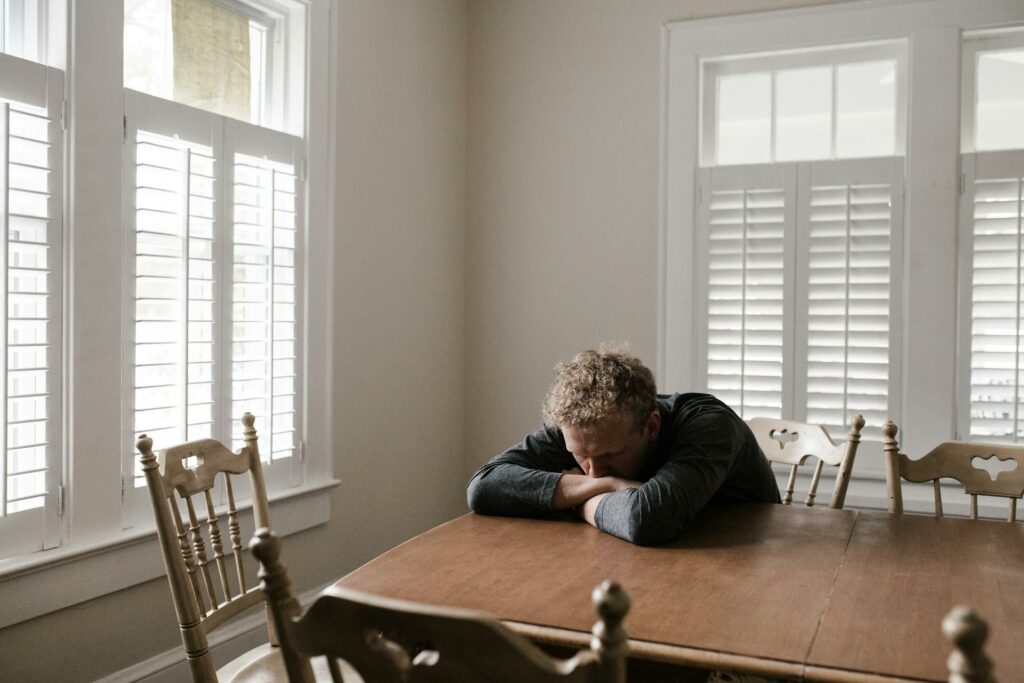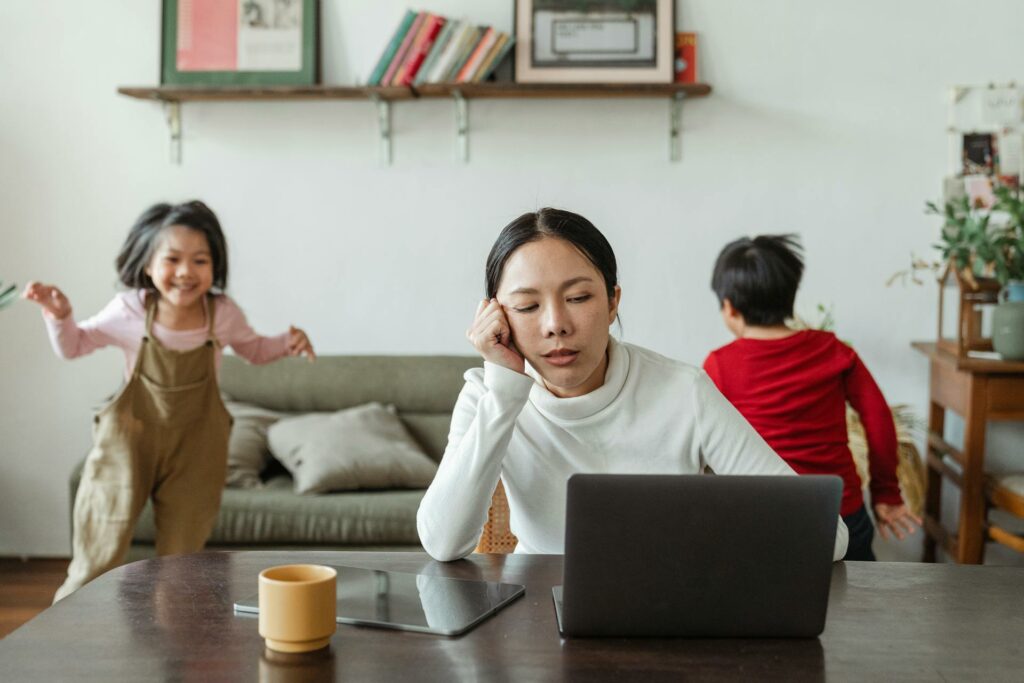
Mindfulness means paying attention to the present moment—on purpose and without judgment.
When practiced consistently, mindfulness for anxiety helps you:
- Interrupt racing, anxious thoughts
- Create space between feelings and reactions
- Lower physical stress responses
Anxiety is common, but it doesn’t have to control you. This article shows how mindfulness can help you manage it—simply, effectively, and with long-term impact.
What Is Mindfulness? What’s Mindfulness Meditation?
Mindfulness means paying attention on purpose to the present moment—without judgment.
It’s not the same as relaxing, daydreaming, or zoning out. Instead, it’s a focused awareness that builds mental clarity and emotional regulation.
Anxiety therapists often incorporate mindfulness techniques into CBT and other therapy methods to enhance their effectiveness.
In particular, mindfulness meditation is a way that you can strengthen this skill through practice. It usually involves:
- Sitting quietly
- Focusing on your breath or body sensations
- Observing thoughts as they come and go—without reacting
Over time, this helps you stay more grounded and calm, even when anxiety or stress shows up.
Read next: Cognitive Distortions- The Hidden Culprits Behind Anxiety
Understanding Anxiety
What Anxiety Feels Like
Anxiety shows up both mentally and physically. Common symptoms include:
- Racing thoughts that won’t slow down
- A tight chest or feeling of pressure
- Shortness of breath or shallow breathing
- General mental overwhelm that makes it hard to focus
These signs can build up fast, making daily life feel harder than it should.
The Mental Loop
Anxiety feeds on itself:
Worry → fear → negative thinking → more worry
Without tools like mindfulness, it’s tough to interrupt this loop. That’s why intentional practice matters.

How Mindfulness Helps Anxiety
1. Awareness and Attention
Mindfulness builds awareness by training you to observe thoughts and sensations without reacting. You start to notice what’s happening in your mind—right as it happens. This creates distance between your thoughts and your sense of self, reducing emotional overwhelm.
2. Acceptance Without Judgment
Mindfulness encourages you to accept thoughts as they are, not label them as “good” or “bad.”
By noticing mental patterns without judgment, you reduce self-criticism and ease feelings of shame. This shift lowers emotional tension over time.
3. Interrupting the Anxiety Cycle
Mindfulness helps rewire how the brain handles stress. When you pause and focus on the present, you slow the anxiety spiral before it builds momentum.
Over time, this creates a buffer between trigger and reaction—giving you more control, clarity, and calm.

5 Helpful Mindfulness Techniques for Anxiety
Mindful Breathing
Shift your focus to the inhale and exhale. Use this during moments of panic or tension to ground yourself. Even 60 seconds of breath awareness can help reset your nervous system.
Body Scan
Gently move your attention through the body—from head to toe. Notice tightness, tingling, or warmth without trying to change it.
This helps release stored physical stress and reconnects mind and body.
Mindful Walking
Walk slowly and focus on each step and movement. Feel your feet touch the ground and your arms swing. You can use this technique indoors or outside for greater present-moment awareness.
Observing Thoughts
Notice thoughts as they come and go—like watching clouds pass. No need to engage, react, or suppress.
This builds mental clarity and helps reduce overwhelm.
Mindful Eating
Eat slowly and pay attention to taste, texture, and smell. Chew thoroughly and pause between bites.
This practice reduces emotional eating and builds gratitude through simple awareness.
How to Get Started With Mindfulness Meditation
Set Up Your Space
Choose a quiet, comfortable spot with minimal distractions. Turn off notifications and set your phone aside. A calm environment helps your brain settle more easily into the practice.
Start Small
Begin with just 1–5 minutes a day. Don’t worry about doing it perfectly.
The goal is to build consistency, not intensity.
Stick With It
Like any habit, mindfulness gets easier with repetition. Some days will feel easier than others—that’s normal.
Keep showing up, even briefly. Small steps, taken daily, lead to real progress over time.
Scientific Evidence Behind Mindfulness
Research strongly supports the mental health benefits of mindfulness. Studies show it reduces activity in the amygdala, the brain’s stress center. This helps lower reactivity and promote emotional balance.
Additional findings show mindfulness:
- Improves focus and concentration
- Reduces repetitive, anxious thinking
- Just 10 minutes a day can significantly lower anxiety levels
- Offers relief for chronic pain and depression
It’s a low-cost, low-risk approach with measurable benefits—backed by science and effective across all age groups.

Lifestyle Tips That Support Mindfulness & Combat Anxiety
Mindfulness works best when paired with supportive daily habits. Try these simple adjustments to strengthen your practice and reduce anxiety:
- Get enough sleep to help your brain reset
- Limit caffeine and stimulants that fuel restlessness
- Move your body regularly—walk, stretch, or exercise
- Stay connected by talking with friends, family, or a therapist
- Use breath work in stressful moments to stay grounded
These habits reinforce calm and build emotional resilience.
Start Your Path with Mindfulness for Anxiety
Mindfulness for anxiety is simple, effective, and backed by science. It’s a skill you can build—with real benefits for your mind and body.
Ready to get started with expert support? Contact licensed therapist David Ejchorszt at About Balance Counseling to begin your journey today!
FAQs
What is mindfulness in simple terms?
Mindfulness is paying attention to the present moment—on purpose and without judgment.
Can mindfulness help during panic attacks?
Yes. Focusing on your breath can help calm your body and interrupt panic symptoms.
How long until mindfulness works?
Many people notice results from mindfulness in a few weeks with consistent practice.
Can mindfulness replace anxiety meds?
Not always. It can complement treatment but talk to your doctor before making changes.
What’s the difference between mindfulness and meditation?
Mindfulness is a mental state. Meditation is one way to train it.
Is mindfulness backed by science?
Yes! Research about mindfulness shows it reduces stress, improves focus, and lowers anxiety.
Are mindfulness apps helpful?
Yes! Many mindfulness apps offer guided sessions that are great for beginners.
Can mindfulness be harmful if done wrong?
Mindfulness won’t be harmful, but sometimes you may feel frustrated. Go slow and stay patient.
